Find Trade Colleges
Pipefitting/Pipefitter and Sprinkler Fitter
Types of Degrees Pipefitting/Pipefitter and Sprinkler Fitter Majors Are Getting
The following table lists how many pipefitting/pipefitter & sprinkler fitter graduations there were in 2021-2022 for each degree level.
| Education Level | Number of Grads |
|---|---|
| Undergraduate Certificate | 394 |
| Associate Degree | 145 |
| Basic Certificate | 124 |
What Pipefitting/Pipefitter and Sprinkler Fitter Majors Need to Know
O*NET surveyed people in occupations related to pipefitting/pipefitter and sprinkler fitter and asked them what knowledge areas, skills, and abilities were important for their jobs. The responses were rated on a scale of 1 to 5 with 5 being most important.
Knowledge Areas for Pipefitting/Pipefitter and Sprinkler Fitter Majors
According to O*NET survey takers, a major in pipefitting/pipefitter and sprinkler fitter should prepare you for careers in which you will need to be knowledgeable in the following areas:
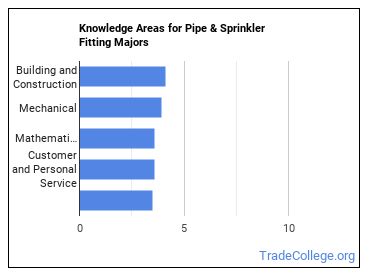
- Building and Construction - Knowledge of materials, methods, and the tools involved in the construction or repair of houses, buildings, or other structures such as highways and roads.
- Mechanical - Knowledge of machines and tools, including their designs, uses, repair, and maintenance.
- Mathematics - Knowledge of arithmetic, algebra, geometry, calculus, statistics, and their applications.
- Customer and Personal Service - Knowledge of principles and processes for providing customer and personal services. This includes customer needs assessment, meeting quality standards for services, and evaluation of customer satisfaction.
- English Language - Knowledge of the structure and content of the English language including the meaning and spelling of words, rules of composition, and grammar.
Skills for Pipefitting/Pipefitter and Sprinkler Fitter Majors
pipefitting/pipefitter and sprinkler fitter majors are found most commonly in careers in which the following skills are important:
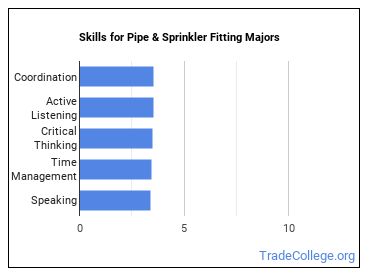
- Coordination - Adjusting actions in relation to others’ actions.
- Active Listening - Giving full attention to what other people are saying, taking time to understand the points being made, asking questions as appropriate, and not interrupting at inappropriate times.
- Critical Thinking - Using logic and reasoning to identify the strengths and weaknesses of alternative solutions, conclusions or approaches to problems.
- Time Management - Managing one’s own time and the time of others.
- Speaking - Talking to others to convey information effectively.
Abilities for Pipefitting/Pipefitter and Sprinkler Fitter Majors
As you progress with your pipefitting/pipefitter and sprinkler fitter degree, there are several abilities you should pick up that will help you in whatever related career you choose. These abilities include:
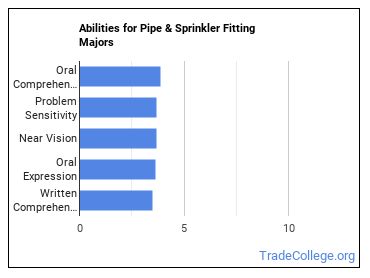
- Oral Comprehension - The ability to listen to and understand information and ideas presented through spoken words and sentences.
- Problem Sensitivity - The ability to tell when something is wrong or is likely to go wrong. It does not involve solving the problem, only recognizing there is a problem.
- Near Vision - The ability to see details at close range (within a few feet of the observer).
- Oral Expression - The ability to communicate information and ideas in speaking so others will understand.
- Written Comprehension - The ability to read and understand information and ideas presented in writing.
What Can You Do With a Pipefitting/Pipefitter and Sprinkler Fitter Major?
People with a pipefitting/pipefitter and sprinkler fitter degree often go into the following careers:
| Job Title | Job Growth Rate | Median Salary |
|---|---|---|
| First-Line Supervisors of Construction Trades and Extraction Workers | 12.6% | $65,230 |
| Pipe Fitters and Steamfitters | 15.6% | $53,910 |
| Solar Energy Installation Managers | 12.6% | $65,230 |
Other Related Pipe & Sprinkler Fitting Programs
Learn about start dates, transferring credits, availability of financial aid, and more by contacting the universities below.
MS in Management - Construction Management
Gain the leadership skills and expertise you need to manage large-scale construction projects with this specialized online master's from Southern New Hampshire University.
Who Is Getting an Associate’s Degree in Pipefitting/Pipefitter and Sprinkler Fitter?
Racial-Ethnic Diversity
At the countrywide level, the racial-ethnic distribution of pipefitting/pipefitter and sprinkler fitter majors is as follows:
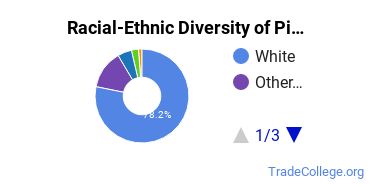
| Race/Ethnicity | Number of Grads |
|---|---|
| Asian | 0 |
| Black or African American | 7 |
| Hispanic or Latino | 6 |
| White | 119 |
| International Students | 1 |
| Other Races/Ethnicities | 12 |
Geographic Diversity
Pipefitting/Pipefitter and Sprinkler Fitter appeals to people across the globe. About 0.7% of those with this major are international students.
How Much Do Pipefitting/Pipefitter and Sprinkler Fitter Majors Make?
Salaries According to BLS
Pipefitting/Pipefitter and Sprinkler Fitter majors often go into careers where salaries can range from $58,150 to $70,540 (25th to 75th percentile). This range includes all degree levels, so you may expect those with a more advanced degree to make more while those with less advanced degrees will typically make less.
To put that into context, according to BLS data from the first quarter of 2020, the typical high school graduate makes between $30,000 and $57,900 a year (25th through 75th percentile). The average person with a bachelor’s degree (any field) makes between $45,600 and $99,000. Advanced degree holders make the most with salaries between $55,600 and $125,400.
Amount of Education Required for Careers Related to Pipefitting/Pipefitter and Sprinkler Fitter
Some degrees associated with pipefitting/pipefitter and sprinkler fitter may require an advanced degree, while others may not even require a bachelor’s in the field. Whatever the case may be, pursuing more education usually means that more career options will be available to you.
How much schooling do you really need to compete in today’s job market? People currently working in careers related to pipefitting/pipefitter and sprinkler fitter have obtained the following education levels.
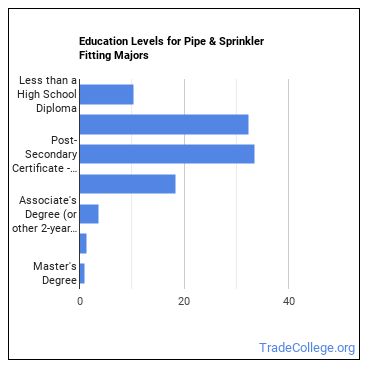
| Education Level | Percentage of Workers |
|---|---|
| Less than a High School Diploma | 10.3% |
| High School Diploma - or the equivalent (for example, GED) | 32.4% |
| Post-Secondary Certificate - awarded for training completed after high school (for example, in agriculture or natural resources, computer services, personal or culinary services, engineering technologies, healthcare, construction trades, mechanic and repair technologies, or precision production) | 33.6% |
| Some College Courses | 18.4% |
| Associate’s Degree (or other 2-year degree) | 3.6% |
| Bachelor’s Degree | 1.2% |
| Master’s Degree | 0.9% |
Online Pipefitting/Pipefitter and Sprinkler Fitter Programs
The following table lists the number of programs by degree level, along with how many schools offered online courses in the field.
| Degree Level | Colleges Offering Programs | Colleges Offering Online Classes |
|---|---|---|
| Certificate (Less Than 1 Year) | 0 | 0 |
| Certificate (1-2 years) | 24 | 0 |
| Certificate (2-4 Years) | 5 | 0 |
| Associate’s Degree | 15 | 0 |
| Bachelor’s Degree | 0 | 0 |
| Post-Baccalaureate | 0 | 0 |
| Master’s Degree | 0 | 0 |
| Post-Master’s | 0 | 0 |
| Doctor’s Degree (Research) | 0 | 0 |
| Doctor’s Degree (Professional Practice) | 0 | 0 |
| Doctor’s Degree (Other) | 0 | 0 |
Is a Degree in Pipefitting/Pipefitter and Sprinkler Fitter Worth It?
The median salary for a pipefitting/pipefitter and sprinkler fitter grad is $58,150 per year. This is based on the weighted average of the most common careers associated with the major.
This is 46% more than the average salary for an individual holding a high school degree. This adds up to a gain of about $365,000 after 20 years!
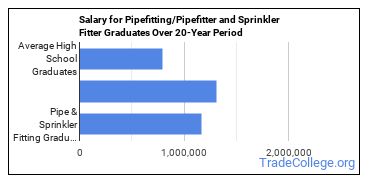
Explore Major by State
Alabama
California
District of Columbia
Idaho
Kansas
Maryland
Mississippi
Nevada
New York
Oklahoma
South Carolina
Utah
West Virginia
Alaska
Colorado
Florida
Illinois
Kentucky
Massachusetts
Missouri
New Hampshire
North Carolina
Oregon
South Dakota
Vermont
Wisconsin
Trades Related to Pipefitting/Pipefitter and Sprinkler Fitter
You may also be interested in one of the following majors related to pipefitting/pipefitter and sprinkler fitter.
| Major | Number of Grads |
|---|---|
| Plumbing Technology/Plumber | 2,209 |
| Other Plumbing & Related Water Supply Services | 11 |
| Well Drilling/Driller | 5 |
| Blasting/Blaster | 0 |
References
*The racial-ethnic minorities count is calculated by taking the total number of students and subtracting white students, international students, and students whose race/ethnicity was unknown. This number is then divided by the total number of students at the school to obtain the racial-ethnic minorities percentage.
- College Factual
- College Scorecard
- National Center for Education Statistics
- O*NET Online
- U.S. Bureau of Labor Statistics
- Usual Weekly Earnings of Wage and Salary Workers First Quarter 2020
- Image Credit: By Tomwsulcer under License
More about our data sources and methodologies.

